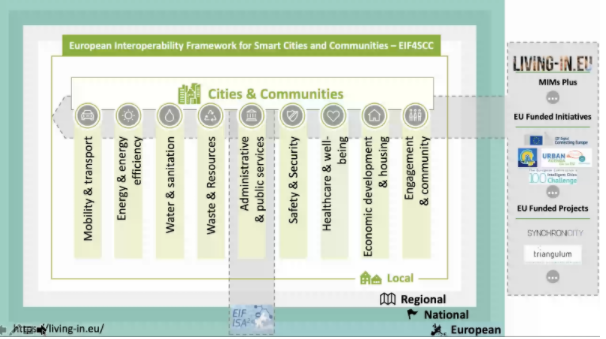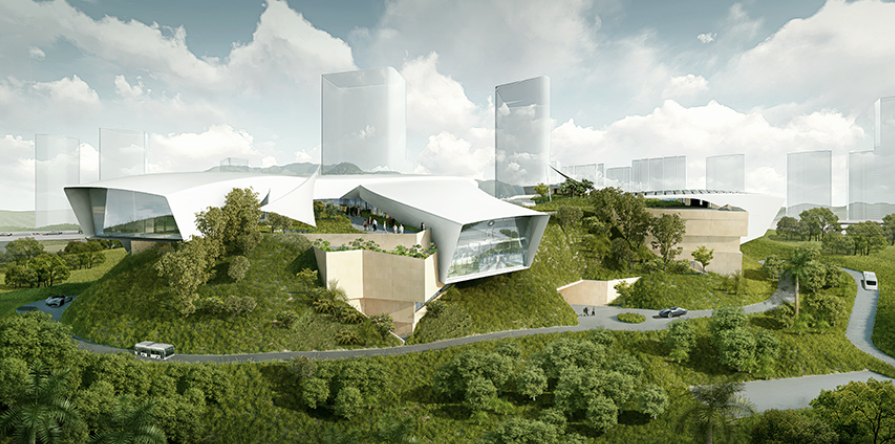By 2050, 65% of the global population is expected to reside in cities. This July, RINNO’s Antonia Egli joined the EU Technology Chamber’s whitepaper launch of ‘10 Key Recommendations for Smart Cities,’ introducing key challenges and requirements for the cities set to be home to an ever-growing number of citizens.
Cities will grow as crucial economic and social nodes in the years to come, yet main challenges in their development result from precisely that – constantly increasing urban populations. The wellbeing of residents can be improved by implementing smart principles in areas like public safety, healthcare, mobility, energy management, and economic development.
The EU Tech Chamber’s Smart Cities Council recently proposed ‘10 Key Recommendations for Smart Cities’ in a virtual launch joined by Dr. Martin Bryskov (Director of the Centre for Digital Transformation in Cities and Communities at, Aarhus University), Michal Postranecky (Architect and Designer), Johan Hallberg (CEO and Founder of Bridgit Technologies AB), Onno Willemse (Founder and CEO of EQYRE), and Karim Elgendy (Sustainable City Strategist, Chatham House Associate Fellow and Lead Urban Sustainability Consultant).
A key issue that was revisited throughout the event was the discrepancy between working with digital technologies in a local context and the standards applied on an international level and in theory. When considering the following, it is essential that such recommendations are consolidated particularly with local governance in mind.
Recommendation 1: Create & Nurture Green Infrastructure
Green spaces are vital for mental and physical health, but what other benefits do they provide? Open space offers room for natural habitats, air quality improvements, reduced pollution, and heightened thermal comfort for citizens. Furthermore, as well as the opportunities that result from their size, research suggests green spaces reduce flood and storm risks.
Recommendation 2: Develop GreenTech
Electrification efforts, increased public transportation offerings, and Mobility-as-a-Service all seek to reduce the number of vehicles in use. But in terms of energy requirements, primary targets focus on increased efficiency rather than quantity reduction. For example, 38% of emissions result from Europe’s built environment, and with Europe’s ever growing urban population as a near unavoidable development, energy consumption and carbon emissions must be drastically reduced. Future green technologies must equally focus on both simple, daily tasks and specialized systems, including recycling, renewable energy sources, alternative fuels, and green nanotechnology.
Recommendation 3: Improve Cybersecurity through Software and Hardware Integration
In light of future developments, industries, governments, and citizens (and their associated smart devices and urban context) must be protected from malicious security breaches. The EU Commission highlights a strategic interest to ensure that the EU focus on retaining “essential capacities to secure its digital economy, society and democracy to protect critical hardware and software and to provide key cybersecurity services.”
Recommendation 4: Establish Free Open Source Platforms
Open collaboration is defined as “any system of innovation or production that relies on goal-oriented yet loosely coordinated participants, who interact to create a product (or service) of economic value, which they make available to contributors and non-contributors alike.” Similarly, access to data through open APIs creates values in processes and makes room for innovation. Given the complexity and size of citizen-centred digital projects, open interfaces and integrated processes are key to democratising, analysing, and sharing smart building data across borders, sectors, and organisations.
Recommendation 5: Rely on the Internet of Things (IoT)
Smart cities are inherently built on IoT technology employing connected sensors to collect and analyse data for infrastructure, public utility, and citizen service improvements. The Internet of Things (‘Things’ in this case referring to smart phones, sensors, wearables etc.) requires software that facilitates the seamless integration and use of connected devices such as smart home systems, security networks and high-speed internet. Here, connectivity is key.
Recommendation 6: Adopt Technological Development
Connectivity may be key, but real-world, sustainable adoption is a challenge not to be underestimated. Case studies of municipalities which have successfully adopted smart tech are particularly useful guides – for example, cities in the US like New Haven, California, are pioneering ‘gigabit communities’ of high speed internet, drone delivery, self-operating grocery carts, multi-functional streetlights, and solar, photovoltaic and wind energy sources. Sustainability is increased through technology adoption as well, reducing wastage, time, and cost throughout construction and use. In a built environment, this boils down to the use of smarter building materials, data-driven construction processes, robotics, 3D printing, and integrated BIM management.
Recommendation 7: Create Sustainable Best Practices
A gap between what is planned and what is constructed is oftentimes clearly visible in Industry 4.0 projects making human, technological, and organisational challenges key factors in the success of deep construction and deep renovation. Connecting processes through digitisation will facilitate new materials, new supply chain organisations, and new movement on construction sites. Guidelines on how to create interoperable digital public services are being consolidated as in the so-called European Interoperability Framework, which focuses on creating data spaces, platforms and local, compatible digital twins based on technical, legal, cultural, and semantic interoperability. Here, use within municipalities, companies, and amongst citizens must be incentivised to ensure EU-wide standardisation.

The European Interoperability Framework for Smart Cities & Communities (source: EU Tech Chamber)
Recommendation 8: Electrify
Electrification, particularly in the transport sector, can cause issues due to an additional load on the electricity grid. Integrated, large-scale processes and synchronization is required to achieve a balance between vehicle electrification, sharing, and automation in the future, when novel sources of electricity and improvements in existing infrastructure can accommodate requirements.
Recommendation 9: Build Circular Economic Models
Reusing building materials and recycling infrastructure enhances value and resource usage in the long term lowering the construction and renovation industries’ virgin resource consumption and demolition waste. This, however, requires the implementation of novel, integrated, and full-lifecycle processes. New developments include a heightened focus on modularity, plug-n-play solutions, and ‘building as material banks’ concepts that work against cradle-to-grave mentalities by either transforming building functionalities or disassembling building components and material feedstock to be upcycled in new constructions.
Recommendation 10: Evolve Urban Office Spaces
“My phone in 2015 had connected power levels similar to NASA in 1969. But my alarm clock in 2015 is functioning exactly as it would have in 1969. The main purpose of designing something must be need-driven!”
Onno Willemse (Founder and CEO of EQYRE)
Following the COVID-19 pandemic, effective home office work has been led by task distribution: what must be done in a collective, and what can be done remotely? In order to better understand this, employees must be put into the center of these processes. Designs of commercial buildings are set to greatly shift in the future to accommodate shared co-working spaces and need-driven, human-centred use.
The EU Tech Chamber is a non-profit organisation that encourages the use of technologies for the benefit of humankind – to strengthen EU tech leaders, to reach the UN’s Sustainability Goals faster, and to give access and opportunities to EU tech advocates.
RINNO is a Horizon 2020 project that aims to considerably accelerate the rate of deep renovation in the EU by reducing the time, efforts, and costs involved. We strive to deliver a set of efficient, environmentally friendly, multi-functional, and easily applicable construction-related innovations that are geared in favour of a more sustainable future.
To keep up to date with project updates you can following H2020-RINNO on Twitter, LinkedIn, Facebook. You can also sign up to receive email updates:


 This project has received funding from the European Union's Horizon 2020 research and innovation programme under grant agreement No 892071.
This project has received funding from the European Union's Horizon 2020 research and innovation programme under grant agreement No 892071.